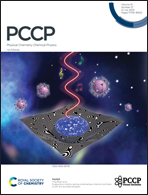Electrostatic interactions – key determinants of the metal selectivity in La3+ and Ca2+ binding proteins
Abstract
Nearly half of all known proteins contain metal co-factors. In the course of evolution two dozen metal cations (mostly monovalent and divalent species) have been selected to participate in processes of vital importance for living organisms. Trivalent metal cations have also been selected, although to a lesser extent as compared with their mono- and divalent counterparts. Notably, factors governing the metal selectivity in trivalent metal centers in proteins are less well understood than those in the respective divalent metal centers. Thus, the source of high La3+/Ca2+ selectivity in lanthanum-binding proteins, as compared with that of calcium-binding proteins (i.e., calmodulin), is still shrouded in mystery. The well-calibrated thermochemical calculations, performed here, reveal the dominating role of electrostatic interactions in shaping the metal selectivity in La3+-binding centers. The calculations also disclose other (second-order) determinants of metal selectivity in these systems, such as the rigidity and extent of solvent exposure of the binding site. All these factors are also implicated in shaping the metal selectivity in Ca2+-binding proteins.



 Please wait while we load your content...
Please wait while we load your content...